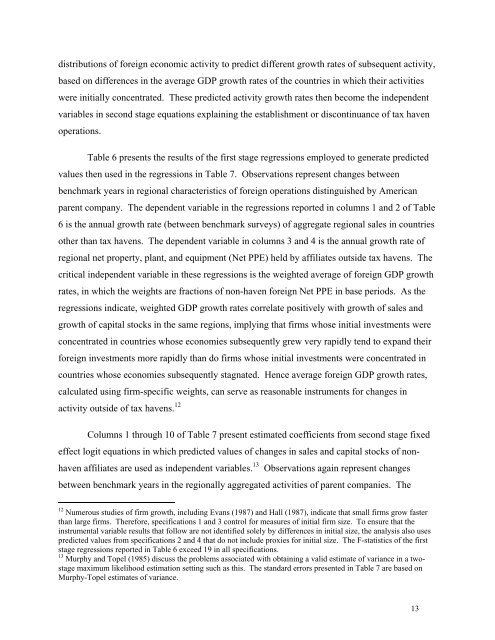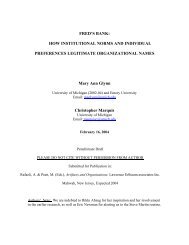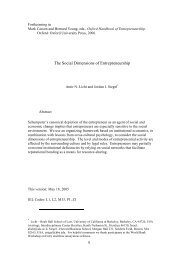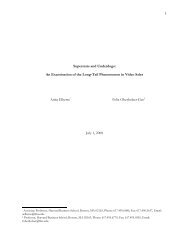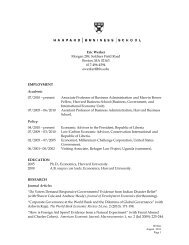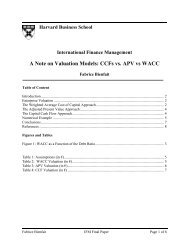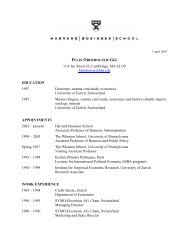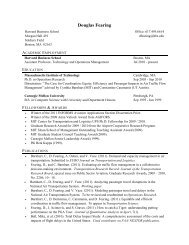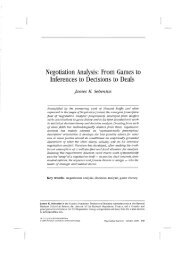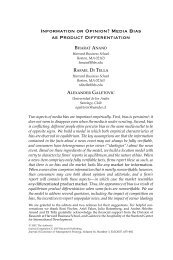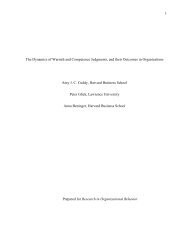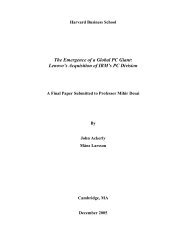The Demand for Tax Haven Operations - Harvard Business School
The Demand for Tax Haven Operations - Harvard Business School
The Demand for Tax Haven Operations - Harvard Business School
You also want an ePaper? Increase the reach of your titles
YUMPU automatically turns print PDFs into web optimized ePapers that Google loves.
distributions of <strong>for</strong>eign economic activity to predict different growth rates of subsequent activity,<br />
based on differences in the average GDP growth rates of the countries in which their activities<br />
were initially concentrated. <strong>The</strong>se predicted activity growth rates then become the independent<br />
variables in second stage equations explaining the establishment or discontinuance of tax haven<br />
operations.<br />
Table 6 presents the results of the first stage regressions employed to generate predicted<br />
values then used in the regressions in Table 7. Observations represent changes between<br />
benchmark years in regional characteristics of <strong>for</strong>eign operations distinguished by American<br />
parent company. <strong>The</strong> dependent variable in the regressions reported in columns 1 and 2 of Table<br />
6 is the annual growth rate (between benchmark surveys) of aggregate regional sales in countries<br />
other than tax havens. <strong>The</strong> dependent variable in columns 3 and 4 is the annual growth rate of<br />
regional net property, plant, and equipment (Net PPE) held by affiliates outside tax havens. <strong>The</strong><br />
critical independent variable in these regressions is the weighted average of <strong>for</strong>eign GDP growth<br />
rates, in which the weights are fractions of non-haven <strong>for</strong>eign Net PPE in base periods. As the<br />
regressions indicate, weighted GDP growth rates correlate positively with growth of sales and<br />
growth of capital stocks in the same regions, implying that firms whose initial investments were<br />
concentrated in countries whose economies subsequently grew very rapidly tend to expand their<br />
<strong>for</strong>eign investments more rapidly than do firms whose initial investments were concentrated in<br />
countries whose economies subsequently stagnated. Hence average <strong>for</strong>eign GDP growth rates,<br />
calculated using firm-specific weights, can serve as reasonable instruments <strong>for</strong> changes in<br />
activity outside of tax havens. 12<br />
Columns 1 through 10 of Table 7 present estimated coefficients from second stage fixed<br />
effect logit equations in which predicted values of changes in sales and capital stocks of nonhaven<br />
affiliates are used as independent variables. 13 Observations again represent changes<br />
between benchmark years in the regionally aggregated activities of parent companies. <strong>The</strong><br />
12 Numerous studies of firm growth, including Evans (1987) and Hall (1987), indicate that small firms grow faster<br />
than large firms. <strong>The</strong>re<strong>for</strong>e, specifications 1 and 3 control <strong>for</strong> measures of initial firm size. To ensure that the<br />
instrumental variable results that follow are not identified solely by differences in initial size, the analysis also uses<br />
predicted values from specifications 2 and 4 that do not include proxies <strong>for</strong> initial size. <strong>The</strong> F-statistics of the first<br />
stage regressions reported in Table 6 exceed 19 in all specifications.<br />
13 Murphy and Topel (1985) discuss the problems associated with obtaining a valid estimate of variance in a twostage<br />
maximum likelihood estimation setting such as this. <strong>The</strong> standard errors presented in Table 7 are based on<br />
Murphy-Topel estimates of variance.<br />
13


